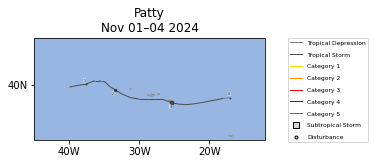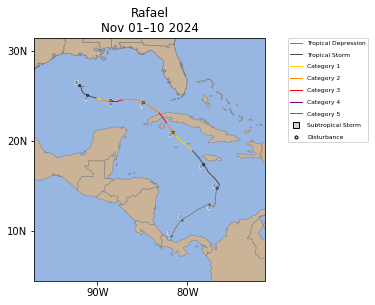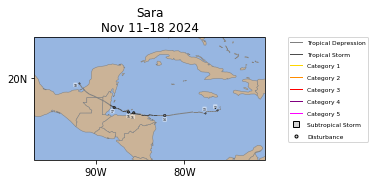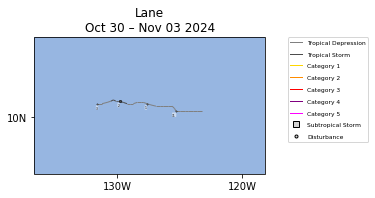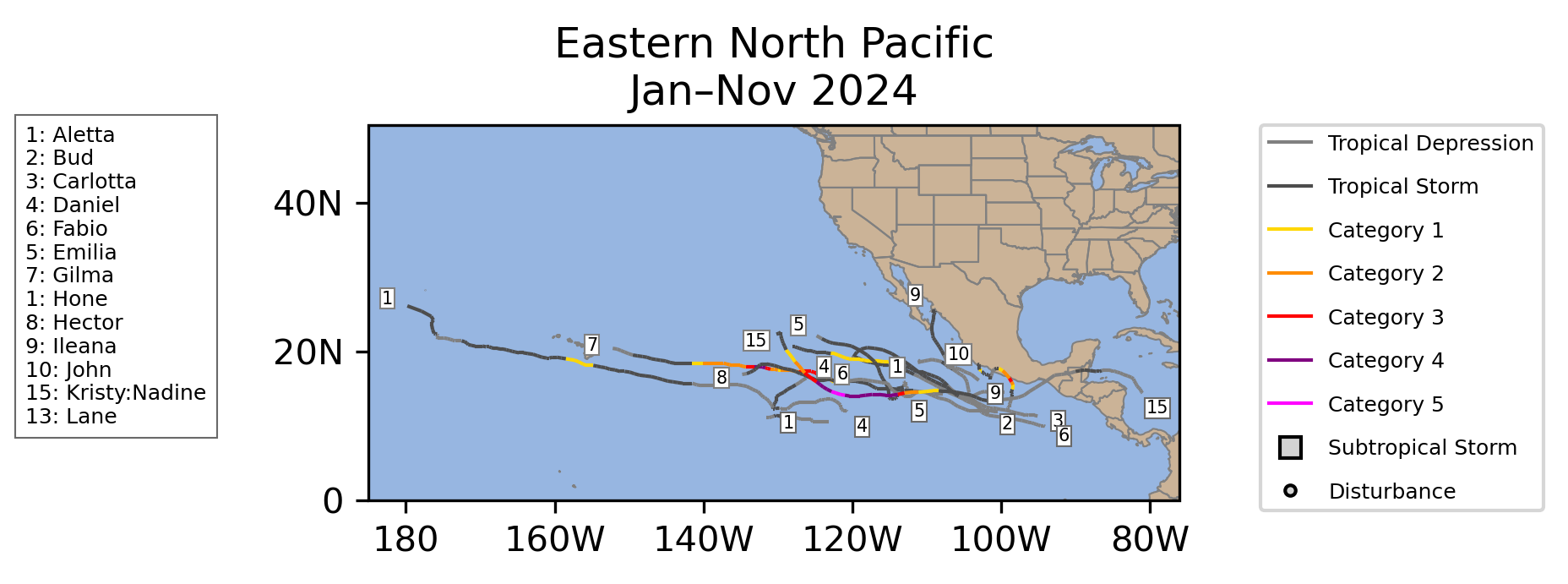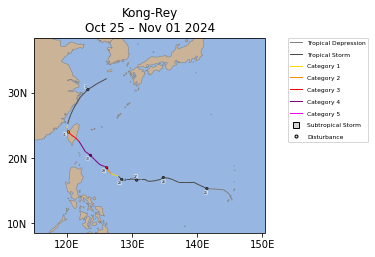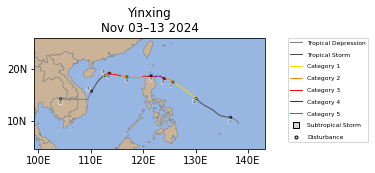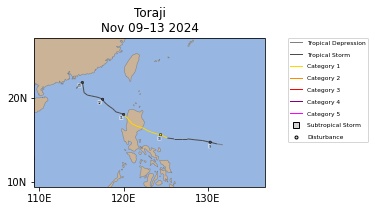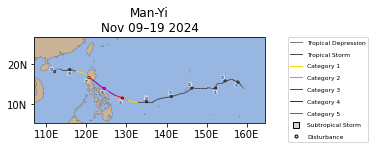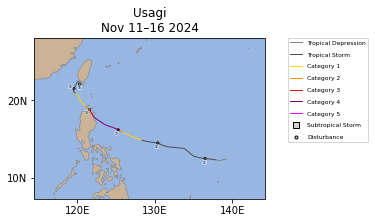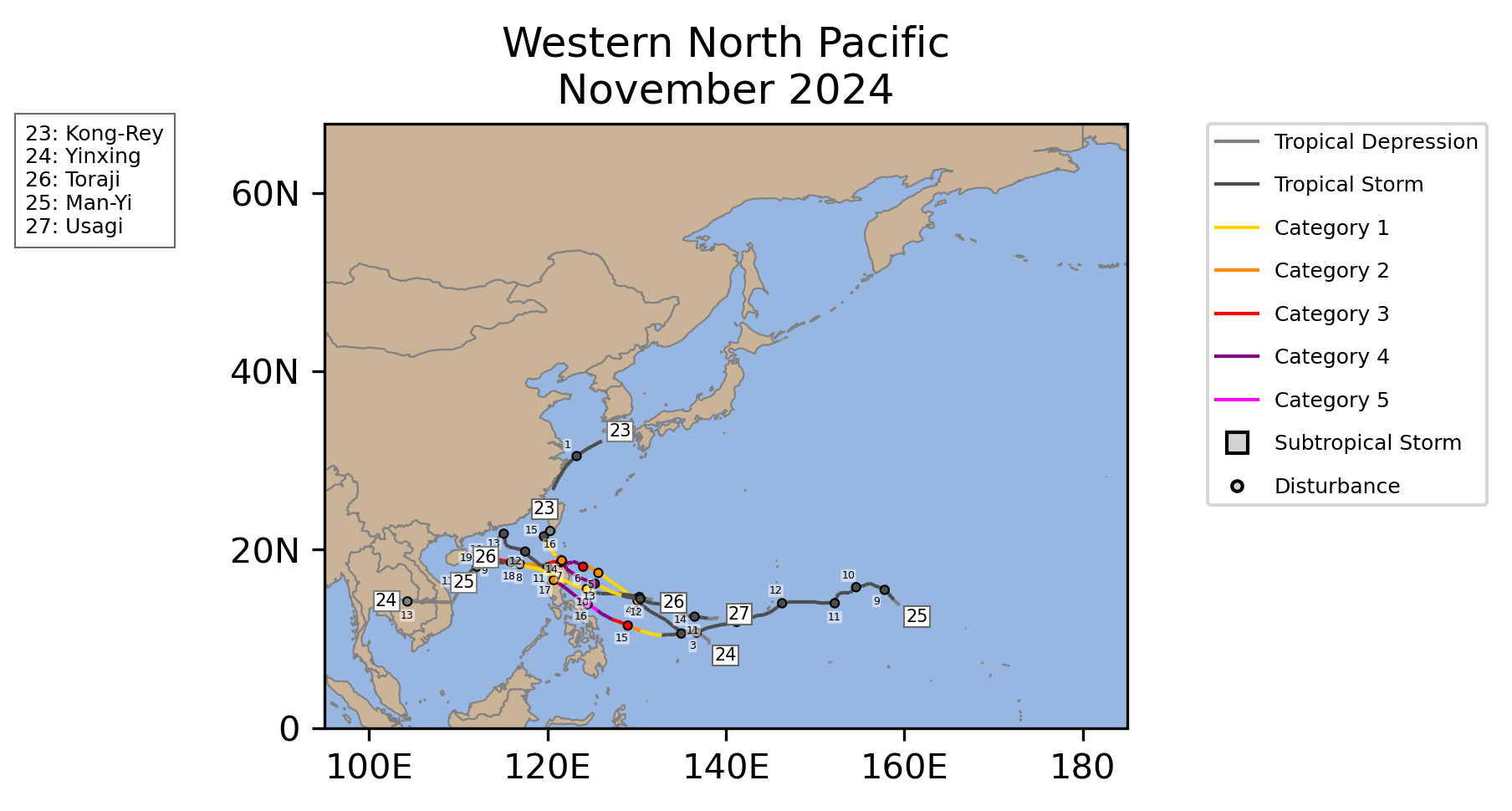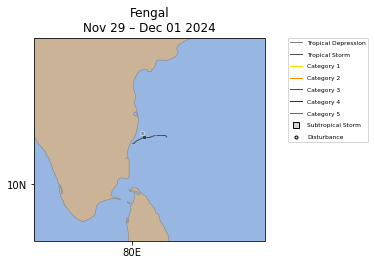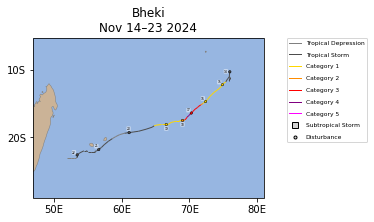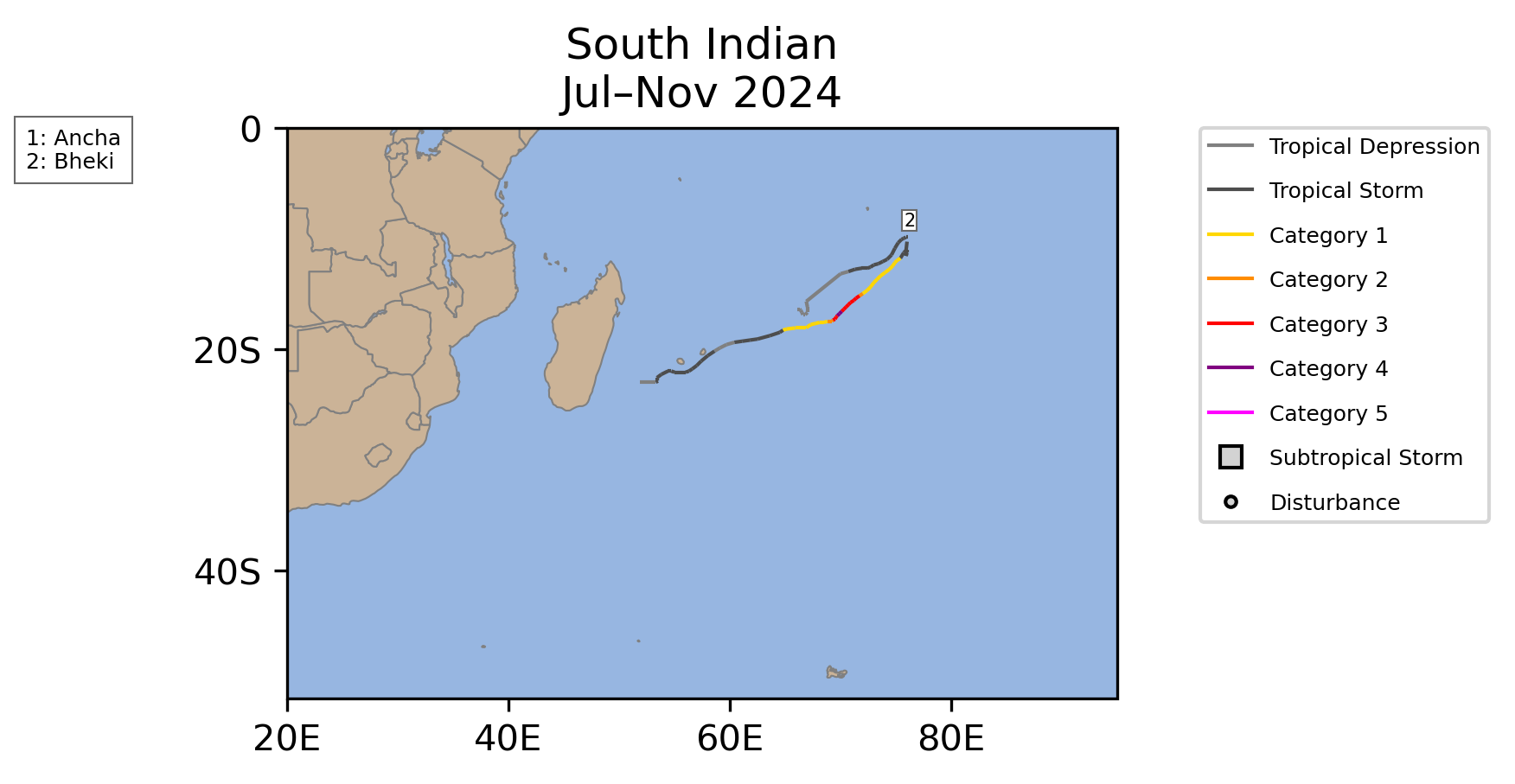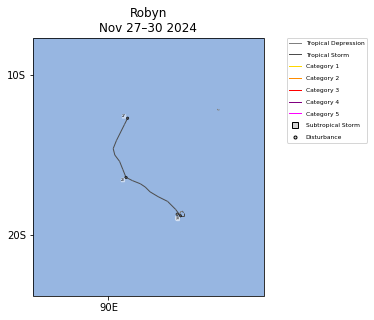Summary

Satellite image of four simultaneous tropical cyclones over the West Pacific on November 11th. From left to right they are Yinxing, Toraji, Usagi, and Man-Yi.
Source: NOAA
Twelve named storms occurred across the globe in November, which was well above the 1991-2020 average of eight. Six of those reached tropical cyclone strength (≥74 mph), and five reached major tropical cyclone strength (≥111 mph). The global accumulated cyclone energy (ACE: an integrated metric of the strength, frequency, and duration of tropical storms) was about 180% of the 1991-2020 average for November.
The Atlantic basin saw three named storms occur during the month of November. This is above the average of 1.0 named storm occurring during November. One tropical cyclone strength storm occurred during the month, which became a major tropical cyclone. This is above the average of 0.6 tropical cyclones and 0.2 major tropical cyclones for November. As a result Atlantic ACE values for the month of November were about 270% higher than average. The first named storm of the month was Tropical Storm Patty, which peaked as a strong tropical storm with maximum sustained winds of 65 mph and a minimum central pressure of 982 mb. The strom brought gusty winds and rain to the Azores as it passed through the islands. The second named storm, Hurricane Rafael peaked as a Category 3 hurricane with maximum sustained winds of 120 mph and a minimum central pressure of 956 mb. The storm formed in the Caribbean and made landfall as a Category 3 hurricane in Cuba causing significant damage. The storm reached its peak intensity after emerging over the Gulf of Mexico becoming an extremely rare November major tropical cyclone in the Gulf of Mexico. The strom then weakened due to unfavorable atmospheric conditions without further impacting land. The final storm of the month, Tropical Storm Sara peaked as a moderate strength tropical storm with maximum sustained winds of 50 mph and a minimum central pressure of 997 mb. The storm brought very heavy rains and flooding to parts of Central America, causing significant damage.
The East Pacific basin saw one named storm form during the month of November. This is near the average of 0.7 named storms occurring during November. The first and only storm, Tropical Storm Lane, peaked as a weak tropical storm with maximum sustained winds of 45 mph and a minimum central pressure of 1004 mb. Lane did not impact land.
The West Pacific basin saw five named storms occur during the month of November, which is above the average of 2.9. The first storm, Super Typhoon Kong-Rey formed in late October but persisted into early November. Kong-Rey peaked as a Category 4 equivalent typhoon with maximum sustained winds of 145 mph and a minimum central pressure of 927 mb before making landfall in Taiwan causing extensive damage. The second storm of the month, Super Typhoon Yinxing peaked as a Category 4 equivalent typhoon with winds of 145 mph and a minimum central pressure of 937 mb. Super Typhoon Yinxing was the first in a series of four typhoons to make landfall in the northern Philippines during November. Following Yinxing was Typhoon Toraji, which made landfall in the northern Philippines at peak intensity with maximum sustained winds of 90 mph and a minimum central pressure of 970 mb. The fourth, and most notable storm of the month was Super Typhoon Man-Yi. Man-Yi peaked as a Category 5 equivalent typhoon with maximum sustained winds of 160 mph and a minimum central pressure of 921 mb. Man-Yi made landfall in the northern Philippines as well as an extremely powerful major tropical cyclone causing significant damage due to high winds, heavy rains, and storm surge. The fifth and final storm of November was Super Typhoon Usagi, which peaked as a Category 4 equivalent typhoon with maximum sustained winds of 145 mph and a minimum central pressure of 915 mb. Usagi also made landfall over the northern Philippines just prior to the arrival of Man-Yi, further exacerbating the damages caused by the other three typhoons which made landfall in the region during the month. The last four named storms of November were at one point all simultaneously active, becoming the first instance of four simultaneous named storms in the West Pacific during the month of November. Overall, due to the extremely high activity ACE values in the West Pacific were over 200% of average for the month.
The North Indian Ocean saw the occurrence of one named storm during the month of November, Cyclonic Storm Fengal. This is below the average of 1.6 named storms during November. Fengal peaked as a moderate tropical storm with maximum sustained winds of 60 mph and a minimum central pressure of 987 mb. The storm brought heavy rains and gusty winds to parts of southern India.
The South Indian Ocean saw the occurrence of one named storm during the month of November, which is average for named storms occurring during the month. The first and only storm, Intense Tropical Cyclone Bheki peaked as a Category 4 equivalent major tropical cyclone with maximum sustained winds of 130 mph and a minimum central pressure of 947 mb. Bheki brought heavy rains and strong winds to Mauritius as the storm passed near the islands as a tropical storm.
The Australian region saw the occurrence of one named storm during November, Tropical Cyclone Robyn. On average 5 named storms form in the Australian region in every 10 Novembers. Tropical Cyclone Robyn peaked as a moderate tropical storm with maximum sustained winds of 60 mph and a minimum central pressure of 988 mb. Robyn did not impact land during its lifetime.
No other storms formed globally during the month of November, which made for a well above average month for tropical cyclones. No storms formed in the Southwest Pacific, which is slightly below the average of 0.6. Through the end of November there have been 82 named storms, 41 tropical cyclone strength storms, and 22 major tropical cyclone strength storms. This is near the average of 82.5 for named storms, slightly below average for tropical cyclones strength storms (45.1), and near the average for major tropical cyclones strength storms (24.2). Global ACE values through the end of October are only about 80% of average.
North Atlantic
| Name |
Maximum CategoryMax Cat |
Dates >39 mph |
Maximum Sustained Winds | Minimum Central Pressure |
|---|---|---|---|---|
| TS | November 2Nov 2-4 | 65 mph | 982 mb | |
| 3 | November 4Nov 4-10 | 120 mph | 956 mb | |
| TS | November 14Nov 14-17 | 50 mph | 997 mb |
| Storm Type | Count | 1991-2020 Mean |
1981-2024 Rank* |
1851-2024 Record |
|---|---|---|---|---|
| Tropical Storm Winds ≥ 39 mph (34 kts) | 3 | 1.0 (10 in 10 Novembers) | 1st (tied with 5 other Novembers) | 4 (1961) |
| Hurricane Winds ≥ 74 mph (64 kts) | 1 | 0.6 (6 in 10 Novembers) | 5th (tied with 15 other Novembers) | 3 (2001, 2022) |
| Major Hurricane Winds ≥ 111 mph (96 kts) | 1 | 0.2 (2 in 10 Novembers) | 2nd (tied with 5 other Novembers) | 2 (2020) |
| Accumulated Cyclone Energy ACE×10⁴ kt² | 16.4 | 6.1 | 6th | 71.0 (1932) |
| Storm Type | Count | 1991-2020 Mean |
1981-2024 Rank* |
1851-2024 Record |
|---|---|---|---|---|
| Tropical Storm Winds ≥ 39 mph (34 kts) | 18 | 14.3 | 9th (tied with 1 other season) | 30 (2020) |
| Hurricane Winds ≥ 74 mph (64 kts) | 11 | 7.2 | 4th (tied with 1 other season) | 14 (2005, 2020) |
| Major Hurricane Winds ≥ 111 mph (96 kts) | 5 | 3.2 | 6th (tied with 4 other seasons) | 7 (2005, 2020) |
| Accumulated Cyclone Energy ACE×10⁴ kt² | 161.6 | 121.7 | 11th | 258.6 (1933) |
East Pacific
| Name |
Maximum CategoryMax Cat |
Dates >39 mph |
Maximum Sustained Winds | Minimum Central Pressure |
|---|---|---|---|---|
| TS | November 2Nov 2-3 | 45 mph | 1004 mb |
| Storm Type | Count | 1991-2020 Mean |
1981-2024 Rank* |
1949-2024 Record |
|---|---|---|---|---|
| Tropical Storm Winds ≥ 39 mph (34 kts) | 1 | 0.7 (7 in 10 Novembers) | 7th (tied with 16 other Novembers) | 2 (9 Novembers) |
| Hurricane Winds ≥ 74 mph (64 kts) | 0 | 0.3 (3 in 10 Novembers) | 10th (tied with 34 other Novembers) | 1 (12 Novembers) |
| Major Hurricane Winds ≥ 111 mph (96 kts) | 0 | 0.1 (1 in 10 Novembers) | 3rd (tied with 41 other Novembers) | 1 (2011, 2015) |
| Accumulated Cyclone Energy ACE×10⁴ kt² | 0.6 | 2.5 | 21st | 14.0 (2015) |
| Storm Type | Count | 1991-2020 Mean |
1981-2024 Rank* |
1949-2024 Record |
|---|---|---|---|---|
| Tropical Storm Winds ≥ 39 mph (34 kts) | 13 | 16.9 | 37th | 27 (1992) |
| Hurricane Winds ≥ 74 mph (64 kts) | 5 | 8.8 | 40th (tied with 1 other season) | 16 (1990, 1992, 2014, 2015) |
| Major Hurricane Winds ≥ 111 mph (96 kts) | 3 | 4.6 | 27th (tied with 5 other seasons) | 11 (2015) |
| Accumulated Cyclone Energy ACE×10⁴ kt² | 82.5 | 132.6 | 36th | 318.1 (2018) |
West Pacific
| Name |
Maximum CategoryMax Cat |
Dates >39 mph |
Maximum Sustained Winds | Minimum Central Pressure |
|---|---|---|---|---|
| 4 | October 25-November 1Oct 25-Nov 1 | 145 mph† | 927 mb† | |
| 4 | November 3Nov 3-11 | 145 mph | 937 mb | |
| 1 | November 9Nov 9-13 | 90 mph | 970 mb | |
| 5 | November 9Nov 9-19 | 160 mph | 921 mb | |
| 4 | November 11Nov 11-15 | 145 mph | 915 mb | |
| †Value occurred in October. | ||||
| ‡Some ACE occurred in October. | ||||
| Storm Type | Count | 1991-2020 Mean |
1981-2024 Rank* |
1945-2024 Record |
|---|---|---|---|---|
| Tropical Storm Winds ≥ 39 mph (34 kts) | 5 | 2.9 | 3rd (tied with 2 other Novembers) | 7 (1947) |
| Typhoon Winds ≥ 74 mph (64 kts) | 4 | 1.8 | 2nd (tied with 1 other November) | 6 (2019) |
| Major Typhoon Winds ≥ 111 mph (96 kts) | 3 | 1.0 (10 in 10 Novembers) | 2nd (tied with 3 other Novembers) | 4 (1947, 1952, 1954, 1992) |
| Accumulated Cyclone Energy ACE×10⁴ kt² | 62.5 | 29.8 | 5th | 130.9 (1954) |
| Storm Type | Count | 1991-2020 Mean |
1981-2024 Rank* |
1945-2024 Record |
|---|---|---|---|---|
| Tropical Storm Winds ≥ 39 mph (34 kts) | 23 | 24.9 | 30th (tied with 5 other seasons) | 37 (1964) |
| Typhoon Winds ≥ 74 mph (64 kts) | 15 | 15.6 | 24th (tied with 3 other seasons) | 25 (1964) |
| Major Typhoon Winds ≥ 111 mph (96 kts) | 9 | 9.0 | 18th (tied with 4 other seasons) | 15 (1957, 1965, 2015) |
| Accumulated Cyclone Energy ACE×10⁴ kt² | 203.9 | 286.0 | 33rd | 522.4 (1997) |
North Indian
| Name |
Maximum CategoryMax Cat |
Dates >39 mph |
Maximum Sustained Winds | Minimum Central Pressure |
|---|---|---|---|---|
| TS | November 29-December 1Nov 29-Dec 1 | 60 mph | 987 mb | |
| ‖Some ACE occurred in December. | ||||
| Storm Type | Count | 1991-2020 Mean |
1981-2024 Rank* |
1972-2024 Record |
|---|---|---|---|---|
| Tropical Storm Winds ≥ 39 mph (34 kts) | 1 | 1.6 | 19th (tied with 20 other Novembers) | 4 (1992, 2013) |
| Cyclone Winds ≥ 74 mph (64 kts) | 0 | 0.7 (7 in 10 Novembers) | 21st (tied with 23 other Novembers) | 2 (8 Novembers) |
| Major Cyclone Winds ≥ 111 mph (96 kts) | 0 | 0.3 (3 in 10 Novembers) | 10th (tied with 34 other Novembers) | 2 (2015, 2019) |
| Accumulated Cyclone Energy ACE×10⁴ kt² | 1.0 | 6.4 | 33rd | 25.5 (1992) |
| Storm Type | Count | 1991-2020 Mean |
1981-2024 Rank* |
1972-2024 Record |
|---|---|---|---|---|
| Tropical Storm Winds ≥ 39 mph (34 kts) | 4 | 4.8 | 21st (tied with 12 other seasons) | 10 (1992) |
| Cyclone Winds ≥ 74 mph (64 kts) | 1 | 1.9 | 20th (tied with 15 other seasons) | 6 (2019) |
| Major Cyclone Winds ≥ 111 mph (96 kts) | 0 | 1.0 | 26th (tied with 18 other seasons) | 5 (2019) |
| Accumulated Cyclone Energy ACE×10⁴ kt² | 7.2 | 21.8 | 33rd | 89.7 (2019) |
South Indian
| Name |
Maximum CategoryMax Cat |
Dates >39 mph |
Maximum Sustained Winds | Minimum Central Pressure |
|---|---|---|---|---|
| 4 | November 14Nov 14-22 | 130 mph | 947 mb |
| Storm Type | Count | 1991-2020 Mean |
1981-2024 Rank* |
1956-2024 Record |
|---|---|---|---|---|
| Tropical Storm Winds ≥ 39 mph (34 kts) | 1 | 1.0 (10 in 10 Novembers) | 12th (tied with 15 other Novembers) | 2 (11 Novembers) |
| Cyclone Winds ≥ 74 mph (64 kts) | 1 | 0.4 (4 in 10 Novembers) | 4th (tied with 11 other Novembers) | 2 (1989, 1997, 2005) |
| Major Cyclone Winds ≥ 111 mph (96 kts) | 1 | 0.3 (3 in 10 Novembers) | 1st (tied with 9 other Novembers) | 1 (11 Novembers) |
| Accumulated Cyclone Energy ACE×10⁴ kt² | 16.1 | 6.9 | 6th | 38.5 (1997) |
| Storm Type | Count | 1991-2020 Mean |
1981-2024 Rank* |
1956-2024 Record |
|---|---|---|---|---|
| Tropical Storm Winds ≥ 39 mph (34 kts) | 2 | 1.7 | 8th (tied with 16 other seasons) | 5 (1997) |
| Cyclone Winds ≥ 74 mph (64 kts) | 1 | 0.5 (5 in 10 seasons) | 5th (tied with 13 other seasons) | 3 (1997) |
| Major Cyclone Winds ≥ 111 mph (96 kts) | 1 | 0.3 (3 in 10 seasons) | 1st (tied with 10 other seasons) | 1 (12 seasons) |
| Accumulated Cyclone Energy ACE×10⁴ kt² | 17.7 | 8.6 | 7th | 47.4 (1997) |
Australia
| Name |
Maximum CategoryMax Cat |
Dates >39 mph |
Maximum Sustained Winds | Minimum Central Pressure |
|---|---|---|---|---|
| TS | November 27Nov 27-29 | 60 mph | 988 mb |
| Storm Type | Count | 1991-2020 Mean |
1981-2024 Rank* |
1956-2024 Record |
|---|---|---|---|---|
| Tropical Storm Winds ≥ 39 mph (34 kts) | 1 | 0.5 (5 in 10 Novembers) | 7th (tied with 13 other Novembers) | 2 (6 Novembers) |
| Tropical Cyclone Winds ≥ 74 mph (64 kts) | 0 | 0.2 (2 in 10 Novembers) | 8th (tied with 37 other Novembers) | 1 (7 Novembers) |
| Major Tropical Cyclone Winds ≥ 111 mph (96 kts) | 0 | 0.0 (0 in 10 Novembers) | 2nd (tied with 43 other Novembers) | 1 (2006) |
| Accumulated Cyclone Energy ACE×10⁴ kt² | 1.8 | 1.4 | 14th | 12.9 (2006) |
| Storm Type | Count | 1991-2020 Mean |
1981-2024 Rank* |
1956-2024 Record |
|---|---|---|---|---|
| Tropical Storm Winds ≥ 39 mph (34 kts) | 1 | 0.8 (8 in 10 seasons) | 11th (tied with 11 other seasons) | 3 (1984, 1997, 2002, 2008) |
| Tropical Cyclone Winds ≥ 74 mph (64 kts) | 0 | 0.2 (2 in 10 seasons) | 8th (tied with 37 other seasons) | 2 (1984) |
| Major Tropical Cyclone Winds ≥ 111 mph (96 kts) | 0 | 0.0 (0 in 10 seasons) | 2nd (tied with 43 other seasons) | 1 (2006) |
| Accumulated Cyclone Energy ACE×10⁴ kt² | 1.8 | 1.7 | 17th | 12.9 (2006) |
Southwest Pacific
No Southwest Pacific Tropical Cyclones occurred during November 2024.
| Storm Type | Count | 1991-2020 Mean |
1981-2024 Rank* |
1956-2024 Record |
|---|---|---|---|---|
| Tropical Storm Winds ≥ 39 mph (34 kts) | 0 | 0.4 (4 in 10 Novembers) | 13th (tied with 32 other Novembers) | 3 (1998) |
| Tropical Cyclone Winds ≥ 74 mph (64 kts) | 0 | 0.2 (2 in 10 Novembers) | 7th (tied with 38 other Novembers) | 3 (1998) |
| Major Tropical Cyclone Winds ≥ 111 mph (96 kts) | 0 | 0.1 (1 in 10 Novembers) | 3rd (tied with 42 other Novembers) | 1 (1991, 1998) |
| Accumulated Cyclone Energy ACE×10⁴ kt² | 0.0 | 1.5 | 13th (tied with 32 other Novembers) | 17.2 (1998) |
| Storm Type | Count | 1991-2020 Mean |
1981-2024 Rank* |
1956-2024 Record |
|---|---|---|---|---|
| Tropical Storm Winds ≥ 39 mph (34 kts) | 0 | 0.6 (6 in 10 seasons) | 15th (tied with 30 other seasons) | 5 (1998) |
| Tropical Cyclone Winds ≥ 74 mph (64 kts) | 0 | 0.2 (2 in 10 seasons) | 7th (tied with 38 other seasons) | 3 (1998) |
| Major Tropical Cyclone Winds ≥ 111 mph (96 kts) | 0 | 0.1 (1 in 10 seasons) | 5th (tied with 40 other seasons) | 1 (1991, 1998, 2007, 2024) |
| Accumulated Cyclone Energy ACE×10⁴ kt² | 0.0 | 2.1 | 14th (tied with 31 other seasons) | 22.0 (1998) |
Global
| Name |
Maximum CategoryMax Cat |
Dates >39 mph |
Maximum Sustained Winds | Minimum Central Pressure |
|---|---|---|---|---|
| 4 | October 25-November 1Oct 25-Nov 1 | 145 mph† | 927 mb† | |
| TS | November 2Nov 2-3 | 45 mph | 1004 mb | |
| TS | November 2Nov 2-4 | 65 mph | 982 mb | |
| 4 | November 3Nov 3-11 | 145 mph | 937 mb | |
| 3 | November 4Nov 4-10 | 120 mph | 956 mb | |
| 1 | November 9Nov 9-13 | 90 mph | 970 mb | |
| 5 | November 9Nov 9-19 | 160 mph | 921 mb | |
| 4 | November 11Nov 11-15 | 145 mph | 915 mb | |
| TS | November 14Nov 14-17 | 50 mph | 997 mb | |
| 4 | November 14Nov 14-22 | 130 mph | 947 mb | |
| TS | November 27Nov 27-29 | 60 mph | 988 mb | |
| TS | November 29-December 1Nov 29-Dec 1 | 60 mph | 987 mb | |
| †Value occurred in October. | ||||
| ‡Some ACE occurred in October. | ||||
| ‖Some ACE occurred in December. | ||||
| Storm Type | Count | 1991-2020 Mean |
1981-2024 Rank* |
1972-2024 Record |
|---|---|---|---|---|
| Tropical Storm Winds ≥ 39 mph (34 kts) | 12 | 7.6 | 1st (tied with 2 other Novembers) | 12 (2019, 2020, 2024) |
| Tropical Cyclone Winds ≥ 74 mph (64 kts) | 6 | 4.1 | 5th (tied with 3 other Novembers) | 9 (2019) |
| Major Tropical Cyclone Winds ≥ 111 mph (96 kts) | 5 | 1.8 | 1st (tied with 2 other Novembers) | 5 (1992, 2020, 2024) |
| Accumulated Cyclone Energy ACE×10⁴ kt² | 98.3 | 54.4 | 6th | 150.6 (1992) |
| Storm Type | Count | 1991-2020 Mean |
1981-2024 Rank* |
1972-2024 Record |
|---|---|---|---|---|
| Tropical Storm Winds ≥ 39 mph (34 kts) | 82 | 82.5 | 19th (tied with 2 other seasons) | 99 (2020) |
| Tropical Cyclone Winds ≥ 74 mph (64 kts) | 41 | 45.1 | 28th (tied with 4 other seasons) | 57 (1990) |
| Major Tropical Cyclone Winds ≥ 111 mph (96 kts) | 22 | 24.2 | 19th (tied with 3 other seasons) | 38 (2015) |
| Accumulated Cyclone Energy ACE×10⁴ kt² | 597.3 | 740.8 | 31st | 1,113.1 (1992) |
Data Description
The data in this report are derived from NCEI's IBTrACS dataset (Knapp et al. 2010; Schreck et al. 2014). IBTrACS tropical cyclone track and intensity data from agencies and sources around the globe. In this report, data from NOAA's National Hurricane Center (NHC) are used for the North Atlantic and East Pacific. The other basins use data from the U.S. Military's Joint Typhoon Warning Center (JTWC).
Historical values use the "best track" data that have been analyzed by forecasters after the season using all available data. Operational procedures and observing systems have changed with time and between regions, which makes these data heterogeneous. Intensity data are generally the most reliable since the early 1970s in the Atlantic (Landsea and Franklin 2013) and since the mid-1980s in other regions (Chu et al. 2002). The number of short-lived storms (≤2 days) has also increased since around 2000 due to improvements in observations and analysis techniques (Landsea et al. 2010).
Values for the current year are provisional values from the operational forecast advisories. IBTrACS obtains these from NCEP's TC Vitals, the NCAR Tropical Cyclone Guidance Project, and NHC provisional data. These values are subject to change during the post-season best track analysis. They also only include 6-hourly storm fixes, which means they may miss special advisories at landfall, peak intensity, etc.
The tropical cyclone seasons in the Southern Hemisphere begin in July and end in June, while the Northern Hemisphere seasons are counted from January to December. Storms are counted in all basins, months, and years in which they occur, which means some storms may appear more than once. However, the global totals only include each storm one time.
References
- Chu, J.-H., C. R. Sampson, A. S. Levine, and E. Fukada, 2002: The joint typhoon warning center tropical cyclone best-tracks, 1945–2000. Naval Research Laboratory, Reference Number NRL/MR/7540-02-16, 22 pp., https://www.metoc.navy.mil/jtwc/products/best-tracks/tc-bt-report.html.
- Knapp, K. R., M. C. Kruk, D. H. Levinson, H. J. Diamond, and C. J. Neumann, 2010: The International Best Track Archive for Climate Stewardship (IBTrACS). Bull. Amer. Meteor. Soc., 91, 363–376, https://doi.org/10.1175/2009BAMS2755.1.
- Landsea, C. W., and J. L. Franklin, 2013: Atlantic Hurricane database uncertainty and presentation of a new database format. Mon. Wea. Rev., 141, 3576–3592, https://doi.org/10.1175/MWR-D-12-00254.1.
- ——, G. A. Vecchi, L. Bengtsson, and T. R. Knutson, 2010: Impact of duration thresholds on Atlantic tropical cyclone counts. J. Climate, 23, 2508–2519, https://doi.org/10.1175/2009JCLI3034.1.
- Schreck, C. J., K. R. Knapp, and J. P. Kossin, 2014: The Impact of Best Track Discrepancies on Global Tropical Cyclone Climatologies using IBTrACS. Mon. Wea. Rev., 142, 3881–3899, https://doi.org/10.1175/MWR-D-14-00021.1.
 NOAA's National Centers for Environmental Information
NOAA's National Centers for Environmental Information
